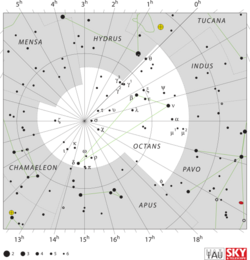Astronomy:Octans
| Constellation | |
 | |
| Abbreviation | Oct[1] |
|---|---|
| Genitive | Octantis |
| Pronunciation | /ˈɒktænz/, genitive /ɒkˈtæntɪs/ |
| Symbolism | the Octant |
| Right ascension | 00h to 24h[1] |
| Declination | −74.30° to −90°[1] |
| Quadrant | SQ4 |
| Area | 291 sq. deg. (50th) |
| Main stars | 3 |
| Bayer/Flamsteed stars | 27 |
| Stars with planets | 3 |
| Stars brighter than 3.00m | 0 |
| Stars within 10.00 pc (32.62 ly) | 1 |
| Brightest star | ν Oct (3.73m) |
| Messier objects | 0 |
| Meteor showers | 0 |
| Bordering constellations | Tucana Indus Pavo Apus Chamaeleon Mensa Hydrus |
| Visible at latitudes between +0° and −90°. Best visible at 21:00 (9 p.m.) during the month of October. Circumpolar | |
Octans (/ˈɒktænz/) is a faint constellation located in the deep Southern Sky. Its name is Latin for the eighth part of a circle, but it is named after the octant, a navigational instrument. Devised by French astronomer Nicolas Louis de Lacaille in 1752, Octans remains one of the 88 modern constellations. The southern celestial pole is located within the boundaries of Octans.
History and mythology
Octans was one of 14 constellations created by French astronomer Nicolas Louis de Lacaille during his expedition to the Cape of Good Hope, and was originally named l’Octans de Reflexion (“the reflecting octant”) in 1752, after he had observed and catalogued almost 10,000 southern stars during a two-year stay at the Cape of Good Hope. He devised fourteen new constellations in uncharted regions of the Southern Celestial Hemisphere not visible from Europe. All but one honoured instruments that symbolised the Age of Enlightenment.[lower-alpha 1][2]
It was part of his catalogue of the southern sky, the Coelum Australe Stelliferum, which was published posthumously in 1763. In Europe, it became more widely known as Octans Hadleianus, in honor of England mathematician John Hadley, who invented the octant in 1730. There is no real mythology related to Octans, partially due to its faintness and relative recentness, but mostly because of its extreme southerly latitude.[3]
Notable features
Stars

Octans is a generally inconspicuous constellation with only one star brighter than magnitude 4; its brightest member is Nu Octantis, a spectral class K1 III giant star with an apparent magnitude 3.73. It is 63.3 ± 0.8 light-years distant from Earth.[4]
Beta Octantis is the second brightest star in the constellation.
Polaris Australis (Sigma Octantis), the southern pole star, is a magnitude 5.4 star just over 1 degree away from the true south celestial pole. Its relative faintness means that it is not practical for navigation.[5]
BQ Octantis is a fainter, magnitude 6.82 star located much closer to the South Pole (at less than a degree) than Sigma.
In addition to having the current southern pole star of Earth, Octans also contains the southern pole star of the planet Saturn, which is the magnitude 4.3 Delta Octantis.
The Astronomical Society of Southern Africa in 2003 reported that observations of the Mira variable stars R and T Octantis were urgently needed.[6]
Three star systems are known to have planets. Mu2 Octantis is a binary star system, the brighter component of which has a planet. Nu Octantis A also has a planet orbiting. HD 142022 is a binary system, a component of which is a sunlike star with a massive planet with an orbital period of 1928 ± 46 days. HD 212301 is a yellow-white main sequence star with a hot jupiter that completes an orbit every 2.2 days.
Deep sky objects
NGC 2573 (also known as Polarissima Australis) is a faint barred spiral galaxy that happens to be the closest NGC object to the south celestial pole. NGC 7095 and NGC 7098 are two barred spiral galaxies that are 115 million and 95 million light-years distant from Earth respectively. The sparse open cluster Collinder 411 is also located in the constellation.
Namesakes
USS Octans (AF-26) was a stores ship used by the United States Navy during World War II.
See also
- Octans (Chinese astronomy)
Notes
- ↑ The exception is Mensa, named for the Table Mountain. The other thirteen (alongside Horologium) are Antlia, Caelum, Circinus, Fornax, Horologium, Microscopium, Norma, Pictor, Pyxis, Reticulum, Sculptor and Telescopium.[2]
References
- Citations
- ↑ 1.0 1.1 1.2 "Octans, Constellation Boundary". The Constellations (International Astronomical Union). https://www.iau.org/public/themes/constellations/#oct. Retrieved 10 Mar 2023.
- ↑ 2.0 2.1 Wagman, Morton (2003). Lost Stars: Lost, Missing and Troublesome Stars from the Catalogues of Johannes Bayer, Nicholas Louis de Lacaille, John Flamsteed, and Sundry Others. Blacksburg, Virginia: The McDonald & Woodward Publishing Company. pp. 6–7. ISBN 978-0-939923-78-6.
- ↑ Staal 1988, p. 257.
- ↑ Brown, A. G. A. (August 2018). "Gaia Data Release 2: Summary of the contents and survey properties". Astronomy & Astrophysics 616: A1. doi:10.1051/0004-6361/201833051. Bibcode: 2018A&A...616A...1G. Gaia DR2 record for this source at VizieR.
- ↑ Staal 1988, p. 258.
- ↑ Cooper, Tim (2003). "Presidential address: Amateur Observations – Successes and Opportunities". Monthly Notes of the Astronomical Society of Southern Africa 62: 234–240. Bibcode: 2003MNSSA..62..234C.
- References
- Ridpath, Ian; Tirion, Wil (2017), Stars and Planets Guide, Princeton University Press, ISBN 978-0-691-17788-5
- Staal, Julius D.W. (1988), The New Patterns in the Sky: Myths and Legends of the Stars, The McDonald and Woodward Publishing Company, ISBN 0-939923-04-1
External links
- The Deep Photographic Guide to the Constellations: Octans
- The clickable Octans
- Starry Night Photography : Octans
- Star Tales – Octans
Coordinates: ![]() 22h 00m 00s, −90° 00′ 00″
22h 00m 00s, −90° 00′ 00″
| Wikimedia Commons has media related to Octans. |
 |


